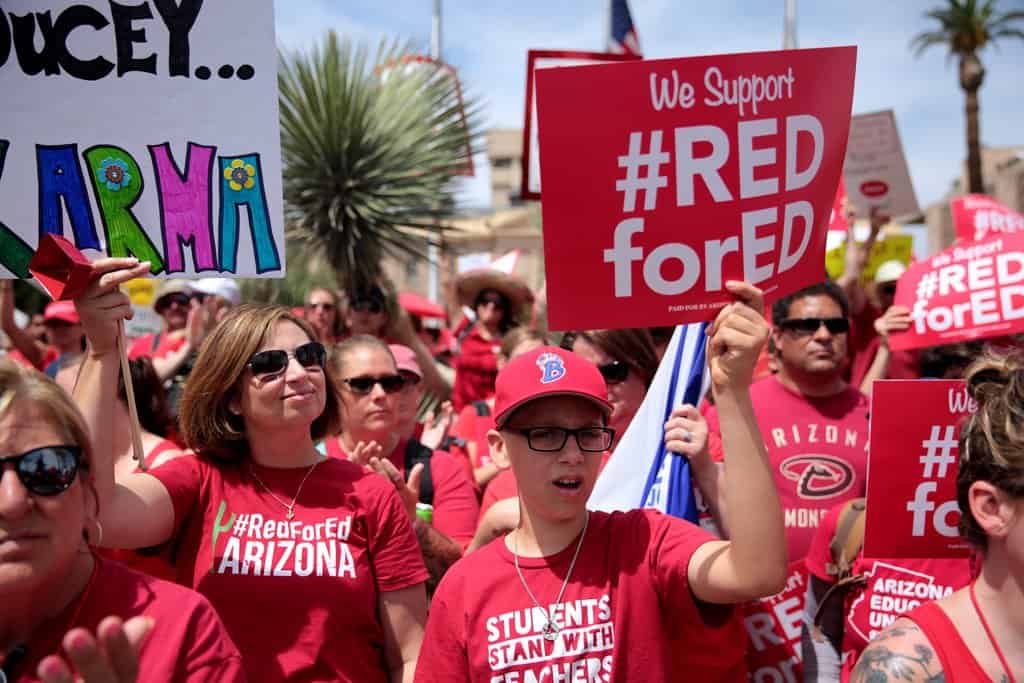
Sharon Block is a Professor of Practice and the Executive Director of the Center for Labor and a Just Economy at Harvard Law School.
Last week, the Labor and Worklife Program at Harvard Law School hosted an event with the National Education Association on the teacher walkouts that spread through red states from January to May 2018. We held this event to learn as much as possible about what motivated tens of thousands of teachers to stand up for themselves and their schools. The most profound lesson I learned was the importance of telling stories of worker power in order to foster worker power.
The “RedforEd” movement has grabbed national attention in the way that few stories about worker collective action have in recent years. The walkouts and the plight of teachers that the walkouts were designed to highlight have been covered in several major news outlets just this month, including lead stories in Time Magazine and the New York Times Magazine. They motivated a record number of teachers to run for political office this cycle. In Oklahoma alone, where one of the early walkouts occurred, dozens of teachers won primaries this summer to unseat incumbents who voted against increased funding for teacher salaries and schools. They became a rare success story for a labor movement in the midst of existential challenges, coinciding with the Supreme Court’s anti-union decision in Janus.
Our event brought together people from all six states where walkouts occurred: West Virginia, Oklahoma, Kentucky, Arizona, Colorado and North Carolina. We heard from the key participants in these events: (1) teachers who led the walkouts, many of whom were either not union members or not leaders in their unions, (2) union officials, who navigated how to support the grassroots movements without coopting them; (3) parents, (4) superintendents who made the decision to close school systems in order to preclude anyone from getting an injunction to stop the walkouts (which would have been unlawful strikes if the schools had stayed open); (5) state legislators from both parties who voted to increase school funding in response to the walkouts; (6) clergy; and (7) other supportive community members. Our objective over the course of our day together was to allow those on the frontlines of the walkouts to tell the story of what happened; to analyze the forces that made the walkouts so successful in driving change; and to understand the implications of the events in those six states for teachers unions and the broader labor movement going forward.
The story our participants told opened with a litany of reasons why the walkouts were unlikely to happen, much less be successful: the law in the six states prohibited teachers from striking, the political environment in those states was very conservative and hostile to unions; and the unions were sitting on the sidelines, willing to accept the meager results the status quo process produced. So how did this wildfire of protest start and spread? It started with a spark lit by memory of a time when workers used collective action to exercise real power to better their lives.
It is no accident that the first walkouts happened in the four counties in West Virginia that make up the heart of coal country. We heard at our event how coal miners’ daughters and granddaughters were at the forefront of those first teacher actions. They shared with us how their memories of their fathers and grandfathers walking out of the mines and onto picket lines when they felt that conditions in the mines had become unbearable inspired their walkouts. They and their communities still had the muscle memory of how to support workers on strike.
The walkouts in West Virginia inspired walkouts in Kentucky – specifically the counties in Kentucky that bordered West Virginia and shared the history of coal mining. Again, we heard from the Kentucky delegation at our conference how they invoked the experience of their coal mining forbearers in motivating their fellow teachers and allies in their communities to stand by them. Coal mining families, they told us, understand the need to be willing to sacrifice and commit to solidarity in order for workers to get what they want. Those initial sparks then spread – success in each state inspired and informed the teachers in the next state.
I take from this narrative an important lesson for those of us who hope to foster a new era of rebalancing worker power in the economy and politics. Yes, the law needs to change to better facilitate worker collective action – that’s why the Labor and Worklife Program has launched the Clean Slate Project to recommend fundamental labor law reform. But rewriting the law is just one facet of the agenda for reinvigorating worker voice and power. As critically, we need to find a way for workers to know and believe in the experience of exercising collective power.
I learned from the #RedforEd teachers that we also need to tell stories of worker power to inspire hearts and minds to strive for success. Marc Solomon, author of Winning Marriage, a history of the successful fight to win LGBT marriage equality, attributed some of that success to the personal experience that so many people have with gay relatives who wanted to get married. As Solomon explained: “An advantage we have is that we are in every family,” Solomon said. “Dick Cheney never has to deal with a poor person, but he has a lesbian daughter. That makes a big difference.”
With union density in the private sector at around six percent, very few American families include a union member, much less a union member who has gone out on strike. (I doubt that anyone in Dick Cheney’s family is a union member, as he comes from a state – Wyoming — where only 6.3% of workers are union members.) This lesson from our conference about the power of personal experience leads to the question of whether there is any substitute for personal history to catalyze a renewal of the labor movement. I believe that we heard at our conference that telling the story of workers coming together and being successful can be powerful too. The teachers in Oklahoma were inspired by the teachers in Kentucky and the teachers in Arizona were inspired by their colleagues in Oklahoma. We’ve seen a similar phenomenon in the Fight for $15 movement. What started as 200 fast food workers walking out in NYC in 2012 became hundreds of thousands of workers taking similar action in more than 300 cities just a few years later. They were moved by the images of people who looked like them standing up for themselves and by the successful campaigns to raise the minimum wage to $15 per hour in states and cities across the country that followed the walkouts – a number thought inconceivable when the protests started.
I came away from our conference inspired by the courage, audacity and civic spirit of the #RedforEd teachers. As the media spreads the #RedforEd story, it will be interesting to see if other workers who feel that the inequality in our economy has become unbearable will be inspired to engage in a new wave of collective action and success.






Daily News & Commentary
Start your day with our roundup of the latest labor developments. See all
April 17
Southern governors oppose UAW organizing in their states; Florida bans local heat protections for workers; Google employees occupy company offices to protest contracts with the Israeli government
April 16
EEOC publishes final regulation implementing the Pregnant Workers Fairness Act, Volkswagen workers in Tennessee gear up for a union election, and the First Circuit revives the Whole Foods case over BLM masks.
April 15
The Supreme Court ruled in favor of bakery delivery drivers in an exemption from mandatory arbitration case; A Teamsters Local ends its 18-month strike by accepting settlement payments and agreeing to dissolve
April 14
SAG-AFTRA wins AI protections; DeSantis signs Florida bill preempting local employment regulation; NLRB judge says Whole Foods subpoenas violate federal labor law.
April 12
The EEOC weighs in on an anti-discrimination lawsuit against Workday; a rule expanding overtime protection moves closer to publication; Amazon decreases spending on anti-union consultants.
April 11
Maine Legislature votes to grant farm workers minimum wage and labor rights; Apple store workers in New Jersey petition to unionize; and Wisconsin Governor vetoes legislation to rollback child labor laws.